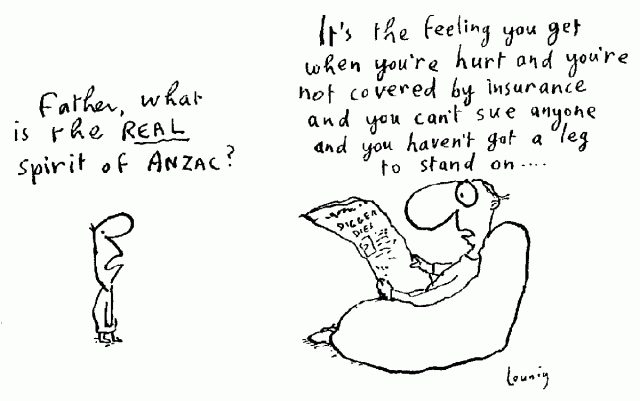Search
Democracy Links
Member's Off-site Blogs
the spirit of ANZAC ....

Australia is leading the world in commemorative spending for World War 1 with $8889 allocated for each digger killed in the Great War compared to just $109 per British casualty and a mere $2 for each dead German soldier.
More than $470 million of the $552 million total spend comes from taxpayers and about $80 million from the private sector.
Figures compiled by the Honest History website show that the Australian outlay is roughly five times more than the UK Government and some 17 times higher than our Anzac brethren across the Tasman.
The $552 million is more than 92 times what Germany is investing.
One of the biggest Australian investments is $100 million for the Sir John Monash Centre at Villers-Bretonneux in France that includes $90 million from the Defence budget and $10 million from Veterans Affairs.
The 483-square-metre interpretative centre will be built behind the imposing Australian National Memorial at Villers-Bretonneux on The Somme and will open by Anzac Day 2018.
According to the government it will tell the Australian war story and highlight the historic July 1918 Le Hamel campaign planned and led by the brilliant and often maligned General John Monash that is credited with shortening the war and saving thousands of lives.
The missing 11,000 of the 290,000 Australians who fought on the Western Front are remembered on the walls of the existing memorial that was dedicated by King George VI in 1938.
Honest History convener David Stephens said the fact that Australia had virtually zero civilian deaths made it simpler to remember combat deaths.
“Collateral damage is always a fraught concept and may be one reason why European countries commemorate less than we do. They saw war up close and have a more realistic appreciation of its effects,” he said
Dr Stephens said many people believed that Australia was ‘born’ as a nation’ at Gallipoli.
“Birthdays have long been an excuse for spending splurges,” he said.
Dr Stephens said many people were amazed by the spending spree but were reluctant to criticise it.
“Spending is important but commemoration is not the state religion.
“We need to focus on the horrors of the Western Front but spending $100 million is over the top.”
Former army officer, Iraq veteran and author of “Anzac’s Long Shadow” James Brown said that in times of tight budgets every dollar spent on commemorating long dead soldiers was a dollar not spent on living soldiers with real issues today.
“We’re spending millions on monuments which catalogue every death in World War I yet until last year no one was tracking the number of returning modern veterans taking their own lives,” Mr Brown said.
“There are direct opportunity costs: $88m from the defence budget spent on a museum in France is $88m not going towards weapons training or personnel costs”.
He said that since his book was published he had been overwhelmed by how many serving defence personnel and veterans shared the view that somehow they’ve been overlooked by the Anzac centenary frenzy.
A spokesman for Veterans Affairs Minister Michael Ronaldson said that unlike the UK and Germany, Australia was a young nation without a history of conflict when war broke out.
“I many ways the Anzac legacy helped forge our national identity and the conflict led to Australia’s coming of age,” he said.
“The government believes that our commemorative program strikes the right balance.”
The Australian War Memorial’s chief historian Ashley Ekins said remembering the sacrifice of the soldiers, especially those caught up in the tragedy of the Somme, was vital.
“As Charles Bean said after observing the carnage, ‘these men should be remembered’.”
THE COST OF REMEMBRANCE
WW1 deaths
Australia = 62,000
New Zealand = 18,100
Canada = 66,000
United Kingdom = 1.012 million
France = 1.737 million
Germany = 2.8 million
THE OUTLAYS
Australia = $552 million or $8889 per death
New Zealand = $31 million or $1713 per death
Canada = $31 million or $465 per death
United Kingdom = $110 million or $109 per death
France = $90 million or $52 per death
Germany = $6 million or $2 per death
Australia spending $8800 per dead WWI soldier Germany spending $2
- By John Richardson at 5 Sep 2015 - 5:32pm
- John Richardson's blog
- Login or register to post comments
Recent comments
5 hours 42 min ago
11 hours 40 min ago
14 hours 43 min ago
17 hours 26 min ago
18 hours 31 min ago
19 hours 59 min ago
22 hours 31 min ago
1 day 5 hours ago
1 day 7 hours ago
1 day 7 hours ago